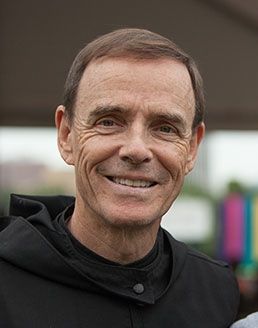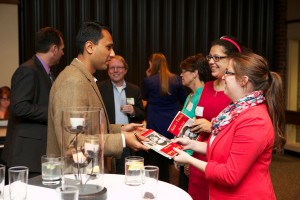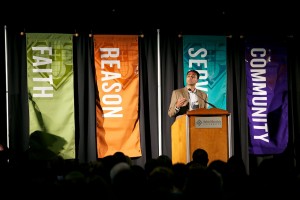

How can a 1,500-year-old book act as a useful guide for how to live together and behave in the 21st century? Further, if it were written by a Catholic monk for other monks, how can the principles it outlines be applied to non-Catholics and those with no specific faith?
Those are the questions Father Edwin Leahy, O.S.B., faced in Newark, New Jersey in 1972, and they are also the guiding force behind the Saint Martin’s University Benedictine Lecture Series. Leahy will deliver the Institute’s fourth annual address at 7:00 p.m. on October 7 at the Norman Worthington Conference Center, located on the Saint Martin’s campus in Lacey.
For Leahy, known as ‘Father Ed,’ the answer was clear: use the methods outlined by St. Benedict in The Rule to revitalize a boys’ prep school in a poverty-stricken neighborhood devastated by civil unrest in 1967.
“Prior to 1967, Saint Benedict’s Preparatory School was a school that had attracted middle class boys from the suburbs,” says Father Kilian Malvey, O.S.B., executive director of the Benedictine Institute at Saint Martin’s. “It was a good choice to go to St. Benedict’s if you wanted to get into a good college. After the 1967 riots, the enrollment began to drop.”
Approximately half of the community of monks left Newark and went to another abbey, leaving the rest of the community behind. “One of the vows that Benedictine monks and sisters take is a vow of stability, the idea that God has led me to this place and I will live my life here,” says Malvey. “These young men took that very seriously and they said, ‘No. We are here to serve the boys in Newark.’”
The school shut down for the 1972-1973 school year as the monks considered how to best deliver a quality education to their new constituents. When it re-opened in 1973, most of the students came from the surrounding neighborhood and were of African-American and Hispanic heritage. Leahy became headmaster when the school re-opened. Today, the school has a nearly 100-percent college acceptance rate. In 2014, a documentary about St. Benedict’s, called The Rule, was released to critical acclaim.

“This documentary makes the point, very clearly, that this school is built on the wisdom and insight of The Rule of St. Benedict,” says Jonathan Dwyer, who taught at the school for three years and today is director of Campus Ministry at Saint Martin’s. “I know, from Father Ed, that part of the way he governs as a headmaster is by rooting everything in his understanding of the rule of St. Benedict.”
“We thought that this is a wonderful opportunity for us,” continues Dwyer. “We’re not a boys’ prep school in Newark; we’re a co-ed university in Washington with our own culture and our own life and challenges but how do we have conversations with students and faculty? For those of us who are Catholic and not Catholic and coming from various perspectives, how does this rule inform who we are as a university?”
Malvey and Dwyer believe Leahy is an excellent fit in the ongoing lecture series. “Our focus has always been monastic Benedictine spirituality that would touch all people, that would have an appeal to our human nature and our spirituality,” explains Malvey. “I have not yet met Father Ed, but any human being might easily give up when faced with the challenges of a school like St. Benedict’s. Watching him and his spirit of dedication and commitment, so full of energy and aliveness, I could see how he’d be an inspiration for the students and the people who work with him.”

Dwyer has worked closely with Malvey in shaping the focus of the Benedictine Institute Lecture Series. “It’s kind of evolving,” he says. “The Institute is new. The mission is to be a vehicle for inculcating our Catholic and Benedictine heritage, identity and spirituality to the university community, but also to the wider Catholic and non-Catholic world beyond the Saint Martin’s campus.”
The first speaker in the series was Eboo Patel, the president and founder of the Interfaith Youth Core. “(Patel) is a Rhodes Scholar Muslim-American whose mission is to build interfaith communities on college university campuses, to help people see the differences between faith and no-faith as a bridge of understanding rather than as a barrier,” says Dwyer. Patel was followed by Dr. Ken Butigan, a Catholic peace activist, and Father William Meninger, a Trappist monk.
Dwyer says that including non-Catholics in the series was in accord with Benedictine teachings. “Within the Benedictine tradition, there is a real sense of community and of our connectedness with each other,” he says. “The movement from there into non-Christians and people of a no-faith community is a logical step.”

Malvey also emphasizes the expansive nature of the tradition. “When the Saint Martin’s Abbey Church was designed, there was that thought of inclusiveness. When you walk in, it’s not like your traditional Roman Catholic church. The architecture and the theology embrace the Quaker faith, the Hindu faith, and the Orthodox faith, as well as the Catholic faith. I always hope that when visitors come to the abbey church, they will have that feeling of being included.”
For those who attend the lecture, Malvey has one wish: “Very simply, I hope it will be an informative experience for them and also a moment of inspiration,” he says. “I hope they will be inspired by the goodness and the richness of The Rule and of Father Edwin.”
For more information about the Benedictine Institute Lecture Series, call (360) 412-6152 or visit the Saint Martin’s University website.
















































